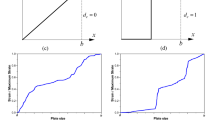Abstract
Experimental evidence of the fractality of fracture surfaces has been widely recognized in the case of concrete, ceramics and other disordered materials. An investigationpost mortem on concrete fracture surfaces of specimens broken in direct tension has been carried out, yielding non-integer (fractal) dimensions of profiles, which are then related to the ‘renormalized fracture energy’ of the material. No unique value for the fractal dimension can be defined: the assumption of multifractality for the damaged, material microstructure produces a dimensional increment of the dissipation space with respect to the number 2, and represents the basis for the so-called multifractal scaling law. A transition from extreme Brownian disorder (slope 1/2) to extreme order (zero slope) may be evidenced in the bilogarithmic diagram: the nominal fracture energyG F increases with specimen size by following a nonlinear trend. Two extreme scaling regimes can be identified, namely the fractal (disordered) regime, corresponding to the smallest sizes, and the homogeneous (ordered) regime, corresponding to the largest sizes, for which an asymptotic constant value ofG F is reached.
Resume
On a largement établi la preuve expérimentale du caractère fractal des surfaces de rupture dans le cas du béton, des céramiques et d'autres matériaux ‘désordonnés’. Une étudepost mortem menée sur des surfaces de rupture d'échantillons cassés par traction directe révèle des dimensions non intégrales (fractales) des profils dont on a établi la relation avec l'énergie de rupture ‘renormalisée’ du matériau. Il n'est pas possible d'établir une valeur unique de la dimension fractale: en présumant la multifractalité de la microstructure du matériau endommagé, on obtient une augmentation dimensionnelle par rapport au numéro 2 et on établit la base de la loi dite d'échelle multifractale. Dans le diagramme à deux logarithmes on peut voir, une transition du désordre de Brown extrême (inclinaison 1/2) à l'ordre extrême (inclinaison zéro); l'énergie de fracture nominaleG F augmente avec les dimensions de l'échantillon suivant une tendance non linéaire. On peut voir deux régimes extrêmes d'échelle, c'est-à-dire le régime fractal désordonné) . qui correspond aux dimensions minimales, et le régime homogène (ordonné), qui correspond aux dimensions maximales pour lesquelles on atteint une valeur constante asymptotique deG F.
Similar content being viewed by others
References
Mandelbrot, B. B., ‘The Fractal Geometry of Nature’ (W. H. Freeman, New York, 1982).
Mandelbrot B. B., Passoja, D. E. and Paullay A. J., ‘Fractal character of fracture surfaces of metals’,Nature 308 (1984) 721–722.
Sumiyoshi, H., Matsuoka, S., Ishikawa, K. and Nihei, M., ‘Fractal characteristics of scanning tunneling microscopic images of brittle fracture surfaces on molybdenum’,Soc. mech. Engrs Inst. J. 35 (1992) 449–455.
Brown, S. R. and Scholz, C. H., ‘Broad bandwidth study of the topography of natural rock surfaces’,J. geophys. Res. 90 (1985) 12575–12582.
Saouma, V. E., Barton, C. C. and Gamaleldin, N. A., ‘Fractal characterization of fracture surfaces in concrete’,Engng Fracture Mech.35 (1990) 47–53.
Davidson, D. L., ‘Fracture surface roughness as a gauge of fracture toughness: aluminium-particulate SiC composites’,J. Mater. Sci. 24 (1989) 681–687.
Wilson, K. G., ‘Renormalization group and critical phenomena’,Phys. Rev. B4 (1971) 3174–3205.
Mandelbrot, B. B., ‘Self-affine fractals and fractal dimension,’Physica Scripta 32 (1985) 257–260.
Richardson, L. F., ‘The problem of contiguity: an appendix of statistics of deadly quarrels.’,General System Yearbook 6 (1961) 139–187.
Brown, S. R., ‘A note on the description of surface roughness using fractal dimension’,Geophys. Res. Lett. 14 (1987) 1095–1098.
Feder, J., ‘Fractals’ (Plenum Press, New York, 1988).
Bouligand, G., ‘Sur la notion d'ordre de mesure d'un ensemble plan’,Bull. Sci. Math. II-52 (1929) 185–192.
Voss, R. F., ‘Random fractal forgeries,’ in ‘Fundamental Algorithms for Computer Graphics’, edited by R. A. Earnshaw (Springer-Verlag, Berlin, 1985) 805–835.
Mandelbrot, B. B. and Van Ness, J. W., ‘Fractional Brownian motions, fractional noises and applications’,SIAM Rev.10 (1968) 422–437.
Hough, S. E., ‘On the use of spectral methods for the determination of fractal dimension’,Geophys. Res. Lett. 16 (1989) 673–676.
RILEM Technical Committee 50, ‘Determination of the fracture energy of mortar and concrete by means of three-point bend tests on notched beams’, Draft Recommendation,Mater. Struct,18 (1985) 287–290.
Carpinteri, A. and Chiaia, B., ‘Fractals, renormalization group theory and scaling laws for strength and toughness of disordered materials’, in: ‘Proceedings of the Workshop Probabilities and Materials: Tests, Models and Applications (PROBAMAT)’, Cachan, France, November 1993 (Kluwer Dordrecht, 1994) pp. 141–150.
Barenblatt, G. I., ‘Similarity, Self-Similarity and Intermediate Asymptotics’ (Consultant Bureau, New York, 1979).
Carpinteri, A., ‘Scaling laws and renormalization groups for strength and toughness of disordered materials’,Int. J. Solids Struct. 31 (1994) 291–302.
Carpinteri, A., Chiaia, B. and Ferro, G., ‘Multifractal nature of material microstructure and size effects on nominal tensile strength’, in: ‘Proceedings of the IUTAM Symposium on Fracture of Brittle Disordered Materials: Concrete, Rock and Ceramics’, Brisbane, Australia, September 1993 (E & FN Spon, London, 1994) pp. 21–34.
Author information
Authors and Affiliations
Rights and permissions
About this article
Cite this article
Carpinteri, A., Chiaia, B. Multifractal nature of concrete fracture surfaces and size effects on nominal fracture energy. Materials and Structures 28, 435–443 (1995). https://doi.org/10.1007/BF02473162
Issue Date:
DOI: https://doi.org/10.1007/BF02473162




